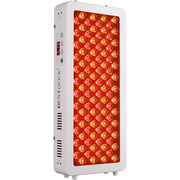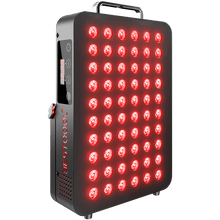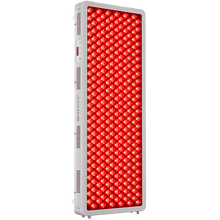Introduction
Ocular rosacea is a chronic inflammatory eye condition in which redness, sensation of burning, stinging, dryness, and light sensitivity are all common symptoms. It usually occurs with facial rosacea (acne-like facial bumps). Although the condition poses no life-threatening risks, the patient struggles with a poor quality of life due to discomfort and complications.
Conventional treatments for ocular rosacea include artificial tears, warm compresses, and antibiotics. These methods may help relieve the symptoms in the short term but cannot fix the core of inflammation. Long-term application may also lead to several side effects, including antibiotic resistance or dependence on artificial tears. As patients continue searching for more effective and sustainable treatments, it is no wonder that red light therapy is becoming a promising alternative option.

What is Red Light Therapy?
Red light therapy involves skin exposure to low-level wavelengths of either red or near-infrared light. It offers a non-invasive treatment to enhance cellular processes that are already active in the skin, like the proliferation of fibroblast and keratinocytes, and to increase circulation. In the late 1960s, red light therapy's use in wound healing and tissue repair incredibly gained popularity. Its recent uses include application for skin conditions, pain relief, and general well-being improvements. Its diverse applications and safe profile drive the growing interest in red light therapy.. This therapy is less risky than aggressive treatments, making it attractive for patients with chronic conditions like ocular rosacea.
How does Red Light Therapy help Ocular Rosacea?
Reduced Inflammation: Inflammation is arguably one of the leading causes of ocular rosacea symptoms. The introduction of red light during therapy penetrates the skin and boosts the production of adenosine triphosphate (ATP), the energy currency of cells. This increases cellular energy, speeds up healing processes, and reduces inflammation, mainly in the soft tissues around the eyes. With its engagement more on inflammation, red light therapy is considered best in combating common symptoms of redness, swelling, and irritation.
Improved Tear Production: Dry eyes are one of the major complaints among those with ocular rosacea. This dryness may be due to malfunctioning meibomian glands that produce the oily layer of tears, keeping them from evaporating. Some studies suggest that red light can improve the activities of these glands, the quality of tears, and dryness.
Relief from Discomfort: The anti-inflammatory effects of red light therapy further extend toward the reduction of visible symptoms. Patients usually also get relief from itching, burning, and stinging sensations attributed to ocular rosacea. Regular red-light therapy sessions can also abate underlying inflammation, making each day more comfortable and easier to tolerate.
Benefits of Red Light Therapy
Non-invasive and Painless: What makes red light therapy remarkable is this feature-non-invasive. This means no needles, incisions, and no application of harsh chemicals on bodies-easy on those with tender skin or eyes. Most users claim it is a comfortable experience, with some even finding the warmth of the soothing light.
Conveniences and Use: Red light therapy devices are now available for home use. They come in portable devices, masks, LED light panels, and more. This makes including therapy in any patient's routine quite easy. The ease of use at home removes the need for frequent visits to the doctor and enables consistent, hassle-free usage.
Long-term Benefits: Unlike treatments that only provide relief for the short term, red light therapy often gives long-term advantages. Because it targets the possible root causes of inflammation and ensures that cellular health is maintained, RLT can be the source of lifelong relief from symptoms and general improvement of ocular conditions.

Combining Red Light Therapy with other treatments
Red light therapy may be promising as a monotherapy for the affection of ocular rosacea, but the benefit will be greater when combined with conventional treatment-such as artificial tears that moisten the eye, making the eye feel moist, especially if the dryness is a chronic problem-used in conjunction with RLT. The effect of RLT could potentially be increased with the use of warm compresses, which could make the consistencies of blocked meibomian glands softer and help the flow of these glands to be lessened, thus decreasing the dryness.
A few patients might still need antibiotics, particularly during the disease's flare-up. Though the addition of RLT might decrease the frequency or dose of the same, the burden of other long-term side effects from antibiotics is reduced. Some other helpful things would include good eyelid hygiene, avoidance of triggers like spicy foods, extreme temperature variation, and overall hydration.
Conclusion
Red light therapy may help fight inflammation, enhance the production of tears, and alleviate discomfort, thereby being conducive to long-term well-being and eye health. Like any other treatment, it is recommended that patients consult with a healthcare provider before red light therapy, especially if they have existing eye problems or are taking medication that can affect their sensitivity to light. Red light therapy provides the potential complementary treatments for patients suffering from ocular rosacea. In short, implementing RLT with other treatments would help patients develop a comprehensive long-term plan targeting multifactor components that occur with ocular rosacea.
References
1. Tavassoli, Shokufeh et al. "Ocular manifestations of rosacea: A clinical review." Clinical & experimental ophthalmology vol. 49,2 (2021): 104-117. doi:10.1111/ceo.13900
2. Husein-ElAhmed, Husein, and Martin Steinhoff. "Light-based therapies in the management of rosacea: a systematic review with meta-analysis." International journal of dermatology vol. 61,2 (2022): 216-225. https://pubmed.ncbi.nlm.nih.gov/34089264/
3. Wu, Shuwei et al. "The effects of photobiomodulation therapy on inflammatory mediators, immune infiltration, and angiogenesis in a mouse model of rosacea." Annals of translational medicine vol. 10,15 (2022): 831. https://pubmed.ncbi.nlm.nih.gov/36035005/
Read More
- Red Light Therapy| Improve Sleep & Wellness – BESTQOOL
- Red Light Therapy | Unlock Wellness & Beauty Benefits – BESTQOOL
- Red Light Therapy Dosing Guide – BESTQOOL
- Red Light Therapy for Newborn Sleep | Enhance Baby's Rest – BESTQOOL
- Red Light Therapy for Fertility | Improve Conception Naturally – BESTQOOL














 Small
Small

 Moderate
Moderate

 Moderate
Moderate

 Moderate
Moderate

 Full
Full



